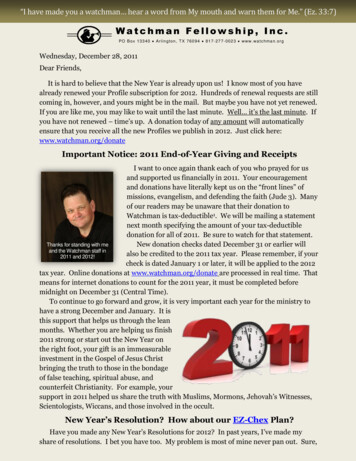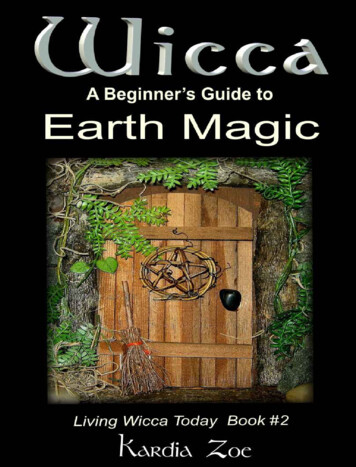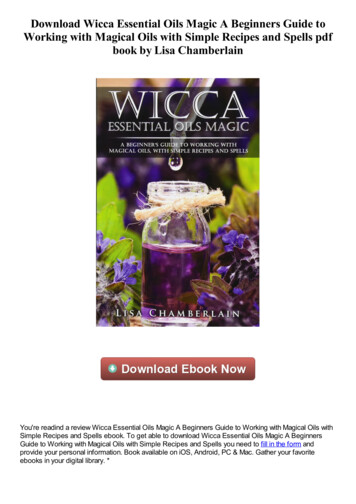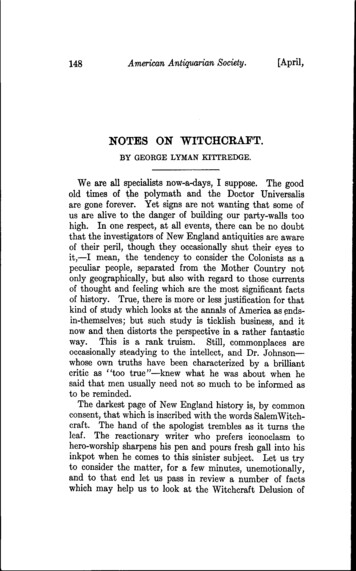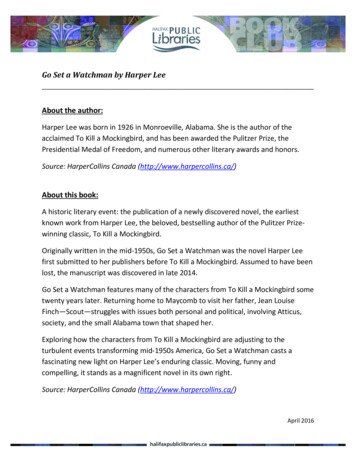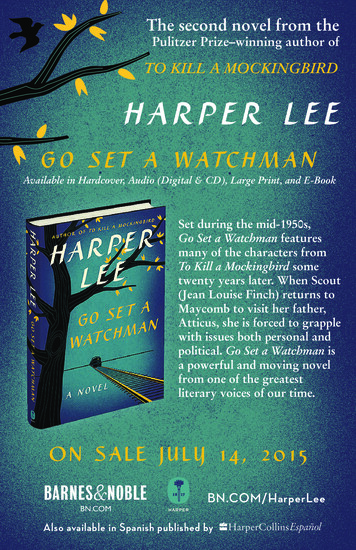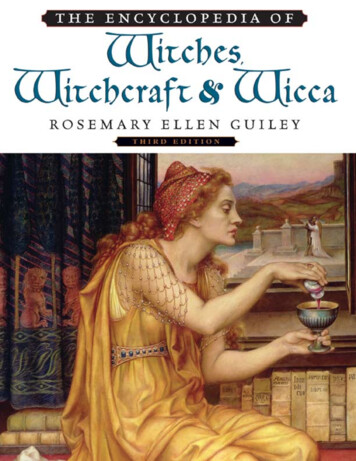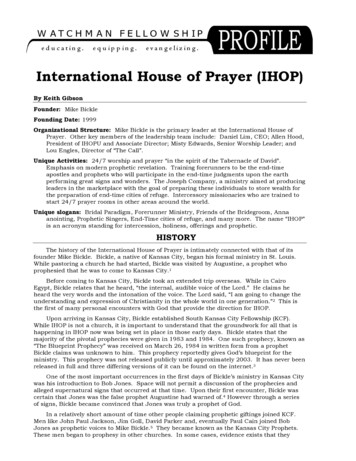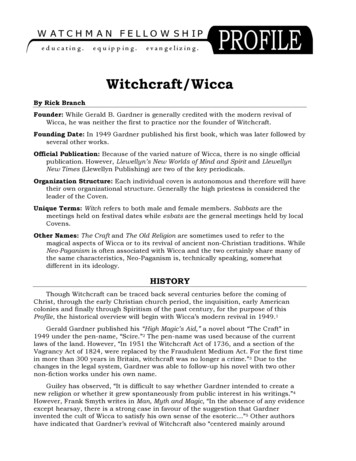
Transcription
Witchcraft/WiccaBy Rick BranchFounder: While Gerald B. Gardner is generally credited with the modern revival ofWicca, he was neither the first to practice nor the founder of Witchcraft.Founding Date: In 1949 Gardner published his first book, which was later followed byseveral other works.Official Publication: Because of the varied nature of Wicca, there is no single officialpublication. However, Llewellyn’s New Worlds of Mind and Spirit and LlewellynNew Times (Llewellyn Publishing) are two of the key periodicals.Organization Structure: Each individual coven is autonomous and therefore will havetheir own organizational structure. Generally the high priestess is considered theleader of the Coven.Unique Terms: Witch refers to both male and female members. Sabbats are themeetings held on festival dates while esbats are the general meetings held by localCovens.Other Names: The Craft and The Old Religion are sometimes used to refer to themagical aspects of Wicca or to its revival of ancient non-Christian traditions. WhileNeo-Paganism is often associated with Wicca and the two certainly share many ofthe same characteristics, Neo-Paganism is, technically speaking, somewhatdifferent in its ideology.HISTORYThough Witchcraft can be traced back several centuries before the coming ofChrist, through the early Christian church period, the inquisition, early Americancolonies and finally through Spiritism of the past century, for the purpose of thisProfile, the historical overview will begin with Wicca’s modern revival in 1949.1Gerald Gardner published his “High Magic’s Aid,” a novel about “The Craft” in1949 under the pen-name, “Scire.”2 The pen-name was used because of the currentlaws of the land. However, “In 1951 the Witchcraft Act of 1736, and a section of theVagrancy Act of 1824, were replaced by the Fraudulent Medium Act. For the first timein more than 300 years in Britain, witchcraft was no longer a crime.”3 Due to thechanges in the legal system, Gardner was able to follow-up his novel with two othernon-fiction works under his own name.Guiley has observed, “It is difficult to say whether Gardner intended to create anew religion or whether it grew spontaneously from public interest in his writings.”4However, Frank Smyth writes in Man, Myth and Magic, “In the absence of any evidenceexcept hearsay, there is a strong case in favour of the suggestion that Gardnerinvented the cult of Wicca to satisfy his own sense of the esoteric ”5 Other authorshave indicated that Gardner’s revival of Witchcraft also “centered mainly around
THE BEST RESOURCE COLLECTION ON CULTS AND RELIGIONSThe Watchman Fellowship ProfileNotebook provides you with an extensive personal library of information about cults, new and alternative religions, world religions, andreligious leaders. You will have atyour fingertips over twenty years ofresearch to answer your questions,strengthen your faith, and improveyour witness to others. Over 100 ProfilesOver 400 pages of informationThe history and primary teachings ofeach groupA Christian responseto deepen your faithand enhance your outreachClick here to order your copy of the watchman fellowship profile notebookBe sure to also order your free subscription to the Watchman Fellowship Profile. Several timeseach year you will receive a new, four-page Profile that you can add to your Profile Notebook, aswell as the latest news from Watchman Fellowship. Click here to order your free subscription!
Witchcraft/Wicca, page 2discreet sexual frolics in the nude, aided by drugs.”6Throughout his life, Gardner was fascinated with many different aspects of theOccult. He had been a follower in varying degrees of such people and philosophies asAleister Crowley, Ordo Templi Orientis, the Hermetic Order of the Golden Dawn andRosicrucianism.7 Historians have credited Doreen Valiente, a follower of Gardner whohe initiated into the Craft in 1953, with “increasing the emphasis on the Goddess.”8While followers of Witchcraft had been in America for hundreds of years, its“greatest growth took place in the 1960s and 1970s, during a general revival ofinterest in Occultism.”9 Many historians of Wicca credit Raymond Buckland and hiswife Rosemary with Wicca’s successful spread into American society. “The Bucklandscame to the U.S. in 1962” having been followers of Gardner.10In 1973, Llewellyn Press, one of the most prolific publishers of Occult material,“sponsored a meeting of Witches in Minneapolis.” The gathering, attended by Witchesfrom seventy-three different Craft traditions, attempted to write a statement ofprinciples. The attempt failed to satisfy all participants. The meeting was followed in1974 by the Council of American Witches which did finally draw-up the Principles ofWiccan Belief. Later, in 1975, thirteen covens would “ratify the Covenant of theGoddess.”11Rosemary Guiley explains why most modern followers prefer the term Wicca toWitchcraft. “As a religion Witchcraft often is called ‘Wicca,’ an Old English term for‘witch,’ in order to counter the negative stereotype of Witches as ugly, evil, and Devilworshipers.”12 Because of their wish to avoid stereotypes and the autonomous natureof Wicca, several key groups have sprung into existence over the past few decades.Some of these groups are the Gardnerian (founded by Gerald Gardner), theAlexandrian (founded by Alexander Sanders), the Dianic (based on the worship of theGreek goddess Diana), the Celtic (based on worship of ancient Celtic myths) andseveral others.13One other group which differs somewhat in its theological perspectives, yet isWiccan in its overall philosophy is the School of Wicca founded by Gavin and YvonneFrost. By some estimates, this group “ may have created a hundred covens throughits activities.”14DOCTRINEAs with most groups that fall under the wide umbrella term of Occultism, thetheology of Wicca varies from group to group and even from coven to coven. However,the following are a few of the doctrines that most Wiccan covens will believe andpractice.Autonomy: “There is no central authority or liturgy; various traditions have theirown rituals, philosophy and beliefs. Some have added elements from Eastern, NativeAmerican Indian, aboriginal and shamanic systems; others have injected politics intotheir traditions. New ritual, songs, chants and poetry are continually created.”15Raymond Buckland explains, “All religions lead in the same direction, simplytaking different paths to get there. Witches feel that all should therefore be free tochoose their own path.”16Experience verses Doctrine: Because of the Autonomy of each Coven and even toa large degree of each individual member of Wicca, the experience of the individual is
Witchcraft/Wicca, page 3of greater importance than any set of dogmatic doctrines. “Generally speaking Witchesare very open-minded people, especially where religion is concerned. They have nohard and fast ‘Commandments,’ no catechisms.”17 Adler adds,By creating our own divinities we create mental steps for ourselves, up which wecan mount toward realizing ourselves as divine The lack of dogma in the Craft,the fact that one can worship the Goddess without believing in Her, that one canaccept the Goddess as ‘Muse’ and the Craft as a form of ancient knowledge to betested by experience—these are precisely the things that have caused the Craft tosurvive, to revive, and to be re-created in this century.18Rituals: These individual or Coven experiences are gained through self-designedrituals.We are talking about the rituals that people create to get in touch with thosepowerful parts of themselves that cannot be experienced on a verbal level Ritualsare also created to acknowledge on this deeper level the movement of the seasonsand the natural world, and to celebrate life and its processes.19Magic: Many of these rituals involve divination or magic.In his book of shadows, Gardner listed eight ways to raise magical power (singly orin combination): (1) meditation or concentration; (2) chants, spells, andinvocations; (3) trance and astral projection; (4) incense, wine and drugs; (5)dancing; (6) blood control by binding parts of the body with cords; (7) scourging(not enough to draw blood); (8) ritual sex.20Goddess Worship: This worship of the Goddess sometimes manifests itself as theworship of “ the Mother Goddess in her three aspects of Maiden, Mother, and Crone.”Sometimes it is the worship of “what we potentially are.”21 In many covens the highpriestess is seen as the personification of the “ mother goddess who is the principaldeity of witchlore.”22Feminism: While not all feminists are Wiccans, many find the philosophy of Wiccato be a compatible philosophy.Women who have come to the Goddess outside the channels of Neo-Paganism andthe Craft are beginning to find rituals and concepts that allow for the same idea.They are finding the Goddess within themselves and within all women. And, asmight be expected, those feminists who have found joy in rituals, and who havediscovered that the concept of ‘Goddess’ feels right inside, are often drawn into theCraft.23Seasonal Festivals: The worship of nature or natural order is of paramountimportance. “Wicca is basically a fertility cult and its great festivals are geared to theseasons.” Key dates in the Wiccan calendar would include February 2 (Candlemas),March 21 (spring equinox), April 30 (Beltane), June 22 (summer solstice), August 1(August Eve), September 21 (autumn equinox), October 31 (Halloween), December 21(winter solstice).24Evil: Wiccan groups do not accept the existence of evil. They explain, “Wicca canbe defined as a pagan mystery religion with a polarized deity and no personification ofevil.” In the Principles of Wiccan Beliefs is stated, “We do not accept the concept of‘absolute evil,’ nor do we worship any entity known as ‘Satan’ or ‘The Devil’ as definedby the Christian tradition.”25
Witchcraft/Wicca, page 4Horned God: As mentioned, some Wiccan covens worship not only a MotherGoddess, but also a masculine deity. “Many Craft traditions also worship a god,related to the ancient horned lord of animals, the god of the hunt, the god of deathand lord of the forests.”26BIBLICAL RESPONSEBecause followers of Wicca do not believe the Bible to be the Word of God, it isdifficult to demonstrate the error of Wicca to a Wiccan from a biblical standpoint.However, from the Christian perspective, Wicca’s theology has been condemned forcenturies.1) Witchcraft and magic (enchantments) are condemned (Lev. 19:26, 31; Deut.18:10-11; 2 Chron. 33:6).2) Worship of other gods (or of goddesses) is condemned (Exodus 20:3; 1 Kings11:4-5).3) Esteeming nature above God is condemned (Romans 1:21-25).4) Satan and his influence of evil are real (Zech. 3:2; Matt. 4:1-11; Luke 6:45).RECOMMENDED READINGThe Occult, Josh McDowell and Don Stewart. This books provides a Christiancritique and overview on such topics as Satanism Divination, New Age Occultism,Spiritism, Magic and Superstition. Soft back, 249 pages.Powers: Testing the Psychic and Supernatural, Dan Korem. While not dealingspecifically with Wicca, this work does provide an excellent biblical examination ofmagic. Since the use of magic is of central importance to believers of Wicca, this bookwould be most valuable to those wishing more information. Soft back, 232 pages.NotesRosemary Ellen Guiley, The Encyclopedia of Witches and Witchcraft (New York: Facts on File, 1989) 368-374.2 Margot Adler, Drawing Down The Moon (Boston: Beacon Press, 1986) 61.3 Guiley, Encyclopedia of Witches and Witchcraft, 374.4 Ibid.5 Richard Cavendish, Man, Myth and Magic: Vol.14 (New York: Marshall Cavendish Corporation, 1970) 1869.6 Leslie Shepard, Encyclopedia of Occultism and Parapsychology Vol. 1 (Detroit: Gale Research Company, 1978) 366.7 Guiley, Encyclopedia of Witches and Witchcraft, 375.8 Ibid.9 Ibid.10 Shepard, 133.11 Adler, 99-103.12 Rosemary Ellen Guiley, Harper’s Encyclopedia of Mystical and Paranormal Experience (New York: HarperSan Francisco, 1991) 647.13 Guiley, Encyclopedia of Witches and Witchcraft, 377-379.14 Adler, 125.15 Guiley, Encyclopedia of Witches and Witchcraft, 376.16 Raymond Buckland, Buckland’s Complete Book of Witchcraft (St. Paul, Minn: Llewellyn Publications, 1986) 99.17 Ibid.18 Adler, 173.19 Ibid, 197-198.20 Guiley, Harper’s Encyclopedia of Paranormal Experience, 649.21 Adler, 10-11, 202.22 Cavendish, 1866.23 Adler, 205.24 Cavendish, 1866.25 Adler, 100, 103.26 Ibid, 11.1Profile is a regular publication of Watchman Fellowship, Inc. Readers are encouraged to begin their ownreligious research notebooks using these articles. Profiles are published by Watchman Fellowshipapproximately 6 times per year, covering subjects such as new religious movements, counterfeitChristianity, the occult, New Age Spirituality, and related doctrines and practices. Complete ProfileNotebooks containing all Profiles published to date are available. Please contact Watchman Fellowshipfor current pricing and availability. All rights reserved 1994.
Be sure to also order your free subscription to the Watchman Fellowship Profile. Several times . Wiccan in its overall philosophy is the School of Wicca founded by Gavin and Yvonne Frost. By some estimates, this group " may have created a hundred covens through . This books provides a Christian critique and overview on such topics as .
